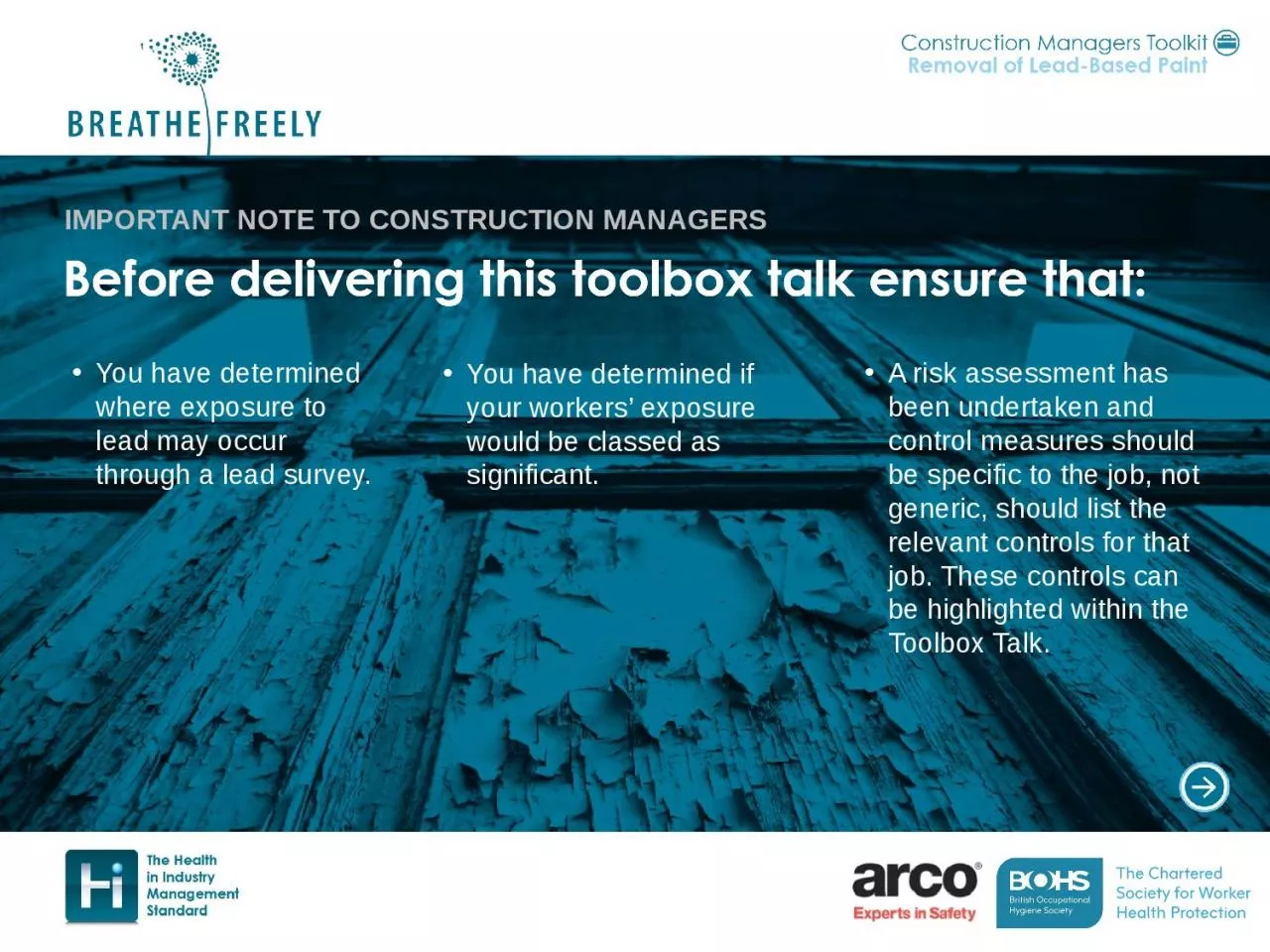

You have determined if your workers exposure would be classed as significant You have determined where exposure to lead may occur through a lead survey IMPORTANT NOTE TO CONSTRUCTION MANAGERS ID: 1043994
Download Presentation The PPT/PDF document "A risk assessment has been undertaken an..." is the property of its rightful owner. Permission is granted to download and print the materials on this web site for personal, non-commercial use only, and to display it on your personal computer provided you do not modify the materials and that you retain all copyright notices contained in the materials. By downloading content from our website, you accept the terms of this agreement.
1. A risk assessment has been undertaken and control measures should be specific to the job, not generic, should list the relevant controls for that job. These controls can be highlighted within the Toolbox Talk.You have determined if your workers’ exposure would be classed as significant.You have determined where exposure to lead may occur through a lead survey.IMPORTANT NOTE TO CONSTRUCTION MANAGERS
2.
3. This paint contains lead and lead is toxic. Prolonged and repeated exposure to lead can damage:the blood and kidneysthe nervous system and brainthe unborn childfertility in men and women. Bad practice picture required
4. Lead poisoning due to continued uncontrolled exposure is rarely seen nowadays in the western world but is still a problem in developing countries, leading to the serious illnesses outlined previously. Over-exposure to lead causes lead poisoning with symptoms such as:stomach pain, constipation and vomitingheadaches, tiredness and irritabilityanaemialoss of weight.Bad practice picture required
5. Lead gets into the body through breathing in dust or fumes, or accidental ingestion for example through eating with dirty hands or hand-to-mouth transfer.Examples of tasks where you are likely to find lead are:Blast removal and burning of old lead paint.Stripping of old lead paint from doors and windows.Hot cutting in demolition and dismantling operations, especially in a confined area within a building.Welding or cutting lead-painted or lead-containing materials.Work that can damage a lead-based paint surface (sanding, hammering, drilling etc.).Bad practice picture required
6. Lead is not found in most modern paints. The sale of lead-based paints to the general public was banned from 1992 but you should remember that it might be present in old paint work and old buildings. For example:Lead was widely used in the past as a pigment.“Red lead” coatings were widely used as anti-corrosion primers on steelwork.“White lead” was used in decorative primers and top coats for internal and external application.Lead can be found in roof flashings, galvanised metal and old lead pipework.Bad practice picture required
7. Lead is not harmful unless it enters the body. The two main routes of exposure are through breathing in the dust or fumes, or accidental ingestion. If old lead paint is flaking or sanded, or lead is heated until visible fumes are given off, then there is a risk of lead exposure. We will:Tell you where lead is present and if the work you are doing will involve any potentially significant exposure to lead. Give you the tools and equipment to minimise dust generation, where options may include:chemical stripping (but this may introduce other health hazards).local extraction (including on-tool extraction for sanders and angle grinders).water to dampen down dust.erecting temporary enclosures around the work area.Protect you by selecting and supplying suitable and appropriate respiratory protective equipment (RPE) and protective clothing.Arrange for exposure monitoring and health surveillance for any work with potentially significant exposure to lead.
8. Never ever dry brush.Wear a respirator if the job will create dust or fumes.Don’t eat, drink or smoke on the job.Keep hands away from your face while you are working.Wash hands and face thoroughly before eating and when leaving work.Report any symptoms of ill-health.Follow the risk assessment and method statement.Use dust suppression methods to reduce the amount of dust generated wherever possible, e.g. wet working and local exhaust ventilation systems.Keep work areas clean and tidy and use a vacuum.Remove unnecessary equipment/material that may get contaminated.Wear your PPE as directed. Wear gloves when handling lead. Remove overalls before you leave the worksite and enter the tea room.Good practice picture required
9. 3Do you have everything you need to protect yourself?Ensure you understand and follow the risk assessment. Make use of the control measures outlined in the risk assessment, for example dust suppression methods such as wet working and local exhaust ventilation systems.Use your PPE, such as gloves and overalls, as directed. Use your respirator as directed.Keep to safe working methods, e.g. keep work areas clean and tidy and use a vacuum, not a dry brush.Maintain careful personal hygiene by keeping hands away from your face when working; washing before eating or leaving work; and never eating, smoking or drinking on the job. Tell your supervisor about any ill-health symptoms.2How can lead get into your body?Lead gets into the body through breathing in dust or fumes, or accidental ingestion for example through eating with dirty hands or hand-to-mouth transfer.1What are the symptoms of lead poisoning?Stomach pain, constipation and vomiting.Headaches, tiredness and irritability.Anaemia.Loss of weight.
10.
11. Visual standards demonstrate ‘what good looks like’.They are intended to reinforce expectations of health and safety standards.
12. Dust suppression methods, such as wet working and local exhaust ventilation systems, are used to prevent dust/fume spreading.Areas are kept clean/tidy and a vacuum is always used.Respirators are used and training is given on their use.There is no eating, drinking or smoking on the job and overalls are removed before leaving the worksite and entering the tea room.The hands and face are washed before eating, toileting, smoking and when leaving work.
13. Sponsored bywww.breathefreely.org.ukCurrent titles in the Toolbox Talks seriesDiesel FumeDust Control in Hard DemolitionDust Control in Soft Strip DemolitionHousekeepingPainting with Brushes and RollersPainting with Brushes and RollersRemoval of Lead-Based PaintSilicaWater Suppression on ToolsWelding FumeWood Dust